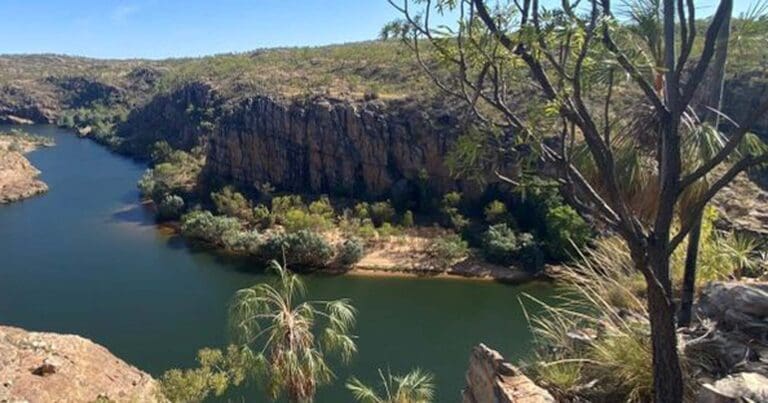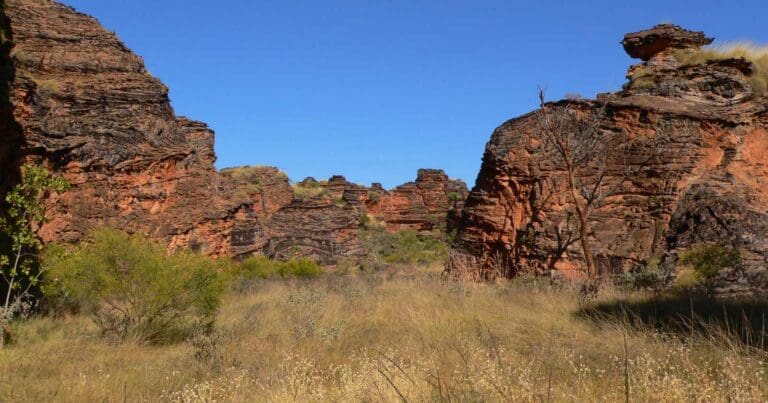Hike at a Glance
Max elevation: 0m
Min elevation: 0m
Total Ascent: 0m
Hike overview
Unveiling breathtaking panoramas of Kakadu National Park, the Twin Falls Plateau (escarpment) Walk is a demanding yet rewarding experience for seasoned hikers. This 6-kilometre return trail (Grade 5) offers a glimpse of the iconic Twin Falls from a unique vantage point above, typically requiring 5 hours to complete.
The challenge begins with a steep ascent through the rugged sandstone country, characteristic of the Arnhem Land plateau. The marked path winds past towering sandstone outcrops and offers a welcome respite in the shade of the ancient anbinik trees. Upon reaching the lookout, prepare to be awestruck by the dramatic 150-metre gorge unfolding beneath you.
This is a challenging yet scenic route, not for the faint of heart. The significant elevation gain and 6-kilometre distance make it best suited for experienced hikers or those seeking a long and rewarding day trip. The reward for your effort is unparalleled - breathtaking views across the floodplains, the escarpment rock formations, and of course, the awe-inspiring Twin Falls cascading down the opposite cliff face.
It's important to remember the cultural significance of this area for the Aboriginal custodians. Treat the land with respect by following leave-no-trace principles and adhering to all signage. The base of Twin Falls is currently closed for cultural reasons, with access limited to the plateau walk during the dry season only. Be sure to check the latest Kakadu Access Report for updates on road conditions and closures before setting off.
Tips
- Heat stress and dehydration are very real dangers here. Take simple steps to keep you and your family safe. Temperatures are considered extreme once it reaches 36 degrees Celsius or above.
- Walk in the cooler parts of the day (before 11.00 am)
- Carry and drink at least one litre of water per person per hour
- Take frequent breaks to eat healthy snacks
- Carry a first aid kit on long bushwalks
Gallery
Got some great shots from this hike? Upload your photos here to inspire others and show off the beauty of the trail!
Click to view form >>
Submitting your photos doesn’t mean you lose ownership. You can be credited for your contributions, and you can request removal at any time.
Content use
Please don’t copy GPX files or content from this site to AllTrails or other platforms. Each trail has been personally mapped, documented, and refined to support Australia’s bushwalking and hiking community. While some details come from land managers, every listing reflects significant personal effort. This is a free, community-driven initiative—your respect helps keep it that way.
Walk map and GPX file
It looks like I don’t have a GPX file for this trail yet. If you have one to share, please email it to me! I’ll verify it against official maps before adding it to help other hikers have a safer, easier experience. Thanks for contributing to a better hiking resource.
Getting there
Getting to the trailhead: Kakadu National Park.
Reaching the Twin Falls trailhead requires careful preparation and a suitable vehicle. Due to the rough, unsealed road conditions, only high clearance four-wheel drive vehicles are permitted to access the area from May to October (dry season). The 50-kilometre journey from Kakadu Highway to the trailhead can be challenging, with corrugations and a narrow, winding track. Trailers are strictly prohibited due to limited space.
You will need a high-clearance 4WD with snorkel due to the deep water crossing at Jim Jim Creek. Allow half an hour each way from Jim Jim Falls. Please adhere to speed limits and drive safely.
Be aware of a potentially deep creek crossing (over 0.4 metres) with a concrete base. A snorkel for your vehicle is highly recommended to ensure safe passage. Always check the latest road conditions before setting off, either online at https://parksaustralia.gov.au/kakadu/access/ or by calling the Bowali Visitor Centre on 08 8938 1120.
Closest towns to this walk: Adelaide River, Arnhem Land, Batchelor, Cooinda, Darwin, Gunbalanya, Humpty Doo, Jabiru, Kakadu Village, Katherine, Maningrida, Mary River, Nourlangie, Pine Creek
About the region
Covering nearly 20,000 square kilometres, Kakadu National Park is a World Heritage listing renowned for both its cultural and natural values. See breathtaking horizons from the top of a Kakadu escarpment. Cruise on the stunning Yellow Water Billabong to spot crocodiles and wildlife in their natural habitat, including millions of migratory birds who in part call the park's wetlands home.
Not only is Kakadu spectacular, but you can feel yourself come alive among the lush rainforests, rocky gorges, serene swimming pools and the oldest Aboriginal rock art in the world. With more than 5,000 Aboriginal rock art sites in the park, the Bininj/Mungguy people have called Kakadu home for some 65,000 years. Here they'll teach you about their ancient culture and the regions' dramatic seasons.
Connect with the oldest living culture on earth. The rugged and remote beauty of Kakadu has stories to share that will take your breath away and touch your heart. In Australia's biggest national park you'll find ancient landscapes with thundering waterfalls, lush rainforests, wandering wetlands, exotic wildlife and ancient rock art.
Kakadu offers unrivalled walks to immerse you in nature, satisfy your appetite for adventure, or nurture your curiosity. Only three hours' drive from Darwin, Kakadu National Park has been waiting for you.
Similar walks nearby
Looking for more walks in or near Kakadu National Park? Try these trails with a similar difficulty grade.
Track grade
Grade 5 (Difficult) - Walks for the Most Experienced: Grade 5 represents the most challenging walking tracks on the AWTGS. These are only recommended for very experienced and fit walkers with specialised skills, including navigation and emergency first aid. Tracks are likely to be very rough, very steep, and unmarked. Walks may be more than 20 kilometers. These challenging walks demand a high level of fitness and experience to navigate difficult terrain, significant elevation changes, and potentially unformed paths.
Explore safe
Plan ahead and hike safely! Carry enough water, pack layers for changing conditions, and bring safety gear like a torch, PLB, and reliable communication device. Check official sources for trail updates, closures, and access requirements, and review local weather and bushfire advice. Most importantly, share your plans with someone before you go. Being prepared makes for a safer and more enjoyable hike! Stay Safe, Explore More, and Always #ExploreSafe.
Packing checklists
What you carry in your pack depends on factors like weather, terrain, and your adventure type. Not sure what to bring? My free planning, food, and packing checklists are a great starting point, covering day hikes, overnight trips, and multi-day adventures. Use them to customise your kit and always prioritise safety.
Let someone know
Before heading out, take a moment to fill out your trip intentions form. It’s a quick way to share your hike details with family or friends. If something goes wrong, they can notify emergency services, ensuring a faster response and peace of mind. Stay safe and enjoy your adventure
Suggest an edit
Spotted a change on this trail? Maybe there are new features, the route has shifted, or the trail is permanently closed. Whatever the update, I’d love your input. Your feedback helps fellow hikers stay informed and ensures that our trail info stays fresh and reliable.
Acknowledgement of Country
Trail Hiking Australia acknowledges the Traditional Owners of the lands on which we hike and pay respects to their Elders, past and present, and we acknowledge the First Nations people of other communities who may be here today.






